You’ll discover that Iowa’s continental climate creates perfect conditions for prairie natives, but choosing the wrong plants can leave your landscape looking sparse and struggling. The state’s temperature swings from -10°F winters to 90°F summers, combined with 30-36 inches of annual rainfall, actually favor specific species over others. While Purple Coneflower and Wild Bergamot seem like obvious choices, there’s a strategic approach to selecting plants that’ll thrive in your exact soil conditions and microclimates.
Contents
- 1 Iowa’s Prairie Climate Characteristics
- 2 Prairie Wildflowers for Iowa
- 3 Iowa Native Prairie Trees
- 4 Iowa Native Prairie Shrubs
- 5 Selecting the Right Native Plants for Your Garden
- 6 Frequently Asked Questions
- 6.1 How Long Does It Take for Prairie Native Plants to Establish?
- 6.2 Can Prairie Plants Survive Iowa’s Harsh Winter Conditions Without Protection?
- 6.3 Where Can I Purchase Native Prairie Seeds and Plants in Iowa?
- 6.4 Do Prairie Plants Require Special Soil Preparation Before Planting?
- 6.5 How Much Maintenance Do Established Prairie Gardens Need Annually?
Iowa’s Prairie Climate Characteristics
When you’re selecting prairie plants for your Iowa landscape, understanding the state’s unique climate characteristics becomes essential for success. Iowa’s prairie climate is continental and subhumid, sitting on the arid side of humid continental zones. You’ll experience distinct four seasons with cold winters averaging 14°F in northwest areas, while southeastern regions stay slightly warmer around 20°F.
Summer temperatures typically reach mid-80s°F, rarely exceeding 100°F. Your plants must handle 20-40 inches of annual precipitation, constant wind exposure, and direct sunlight. This prairie climate demands moisture adaptation strategies from native plants through extensive root systems and specialized wind-resistant features.
Organizations like Iowa Prairie Network work to protect and restore these native prairie ecosystems throughout the state, providing valuable resources for landowners interested in prairie conservation.
Prairie Wildflowers for Iowa
Iowa’s prairie wildflowers offer diverse colors and bloom times throughout the growing season. These native species include vibrant yellows, purples, blues, and specialized milkweeds supporting pollinators. Popular choices like black-eyed susan and wild bergamot provide ecosystem services while creating stunning natural displays in restored prairie landscapes.
Purple Coneflower (Echinacea Purpurea)
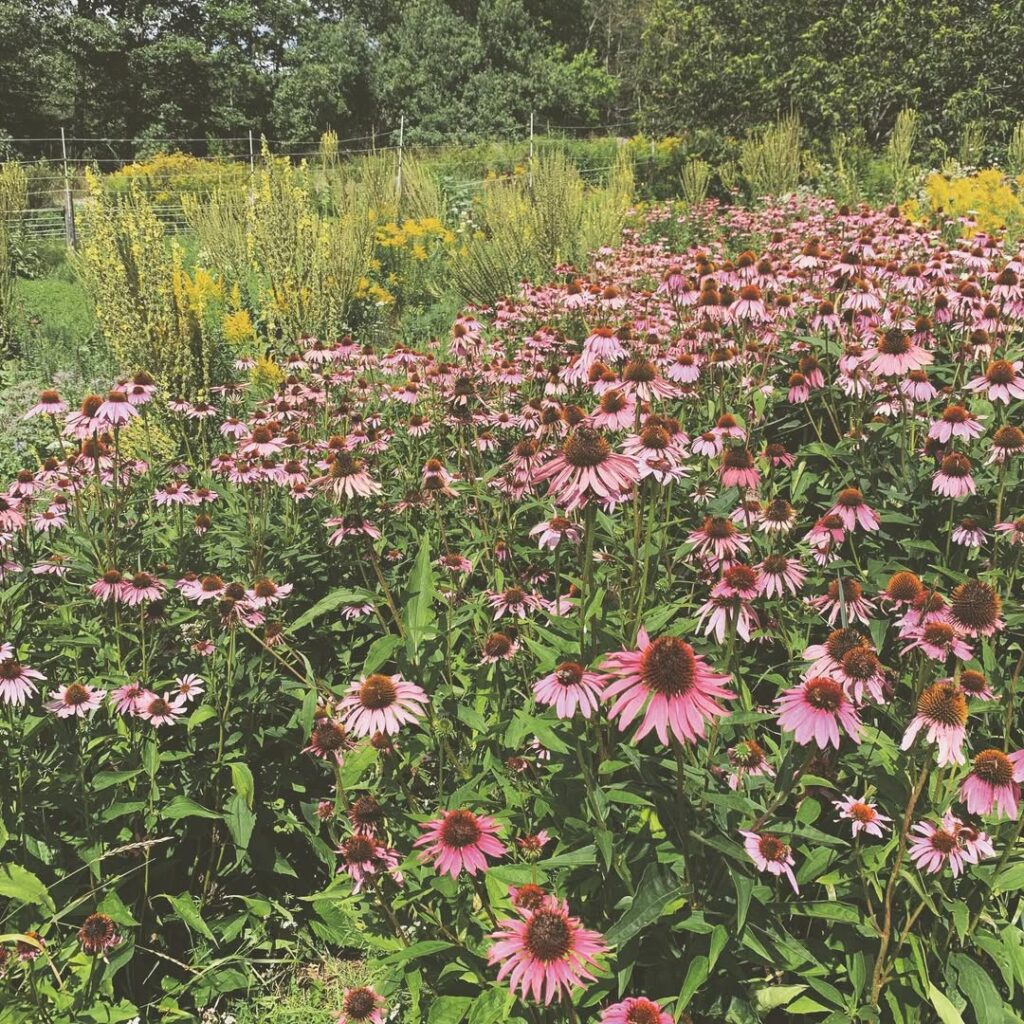
Purple Coneflower is a beloved native perennial that brings vibrant lavender-pink daisy-like blooms to Iowa landscapes from June through August. Growing 2-4 feet tall with distinctive drooping petals and prominent dark centers, this hardy wildflower naturalizes easily and provides exceptional value for both gardeners and wildlife.
The persistent spiky seed heads offer winter interest while attracting goldfinches and other birds. Purple Coneflower’s adaptability to urban conditions and moderate growth rate make it an ideal choice for prairie gardens, naturalistic borders, and rain gardens throughout Iowa. To maintain peak performance, division every 4-6 years is recommended when plants become overcrowded.
- Hardiness: USDA Zone 3, well-suited for Iowa’s climate
- Light: Full sun to partial shade
- Water: Average moisture, well-drained conditions
- Soil: Fertile, well-drained soil; adapts to various soil types
- Fertilizer: Low maintenance; thrives without supplemental feeding
- Pest/Disease Resistance: Generally resistant with few pest issues
- Growth Rate: Moderate growth with upright, clump-forming habit
Wild Bergamot (Monarda Fistulosa)

Wild Bergamot (Monarda fistulosa) is a fragrant perennial herb native to Iowa that grows 1-4 feet tall with gray-green aromatic leaves and clusters of lavender to purple flowers. This member of the mint family blooms from June through September, creating showy displays that attract numerous pollinators including native bees, butterflies, and hummingbirds.
Historically used by Native American tribes for medicinal purposes and sometimes called bee balm or horsemint, Wild Bergamot thrives in prairies, meadows, and disturbed areas. It serves as a host plant for the Raspberry pyrausta butterfly and supports diverse native bee species, making it valuable for pollinator conservation and prairie restoration projects. For successful establishment, prepare a clean, firm seedbed that is weed-free to ensure proper germination and faster plant establishment.
- Hardiness: Native to all regions of Iowa and most of North America
- Light: Full to partial sun
- Water: Medium to dry soil moisture; tolerates drought conditions
- Soil: Tolerates range of soil types except wettest soils; performs well in disturbed ground
- Fertilizer: Low maintenance; no supplemental fertilizer needed once established
- Pest/Disease Resistance: Tolerates neglect and competition with minimal issues
- Growth Rate: Establishes readily; spreads naturally in suitable conditions
Black-Eyed Susan (Rudbeckia Hirta)
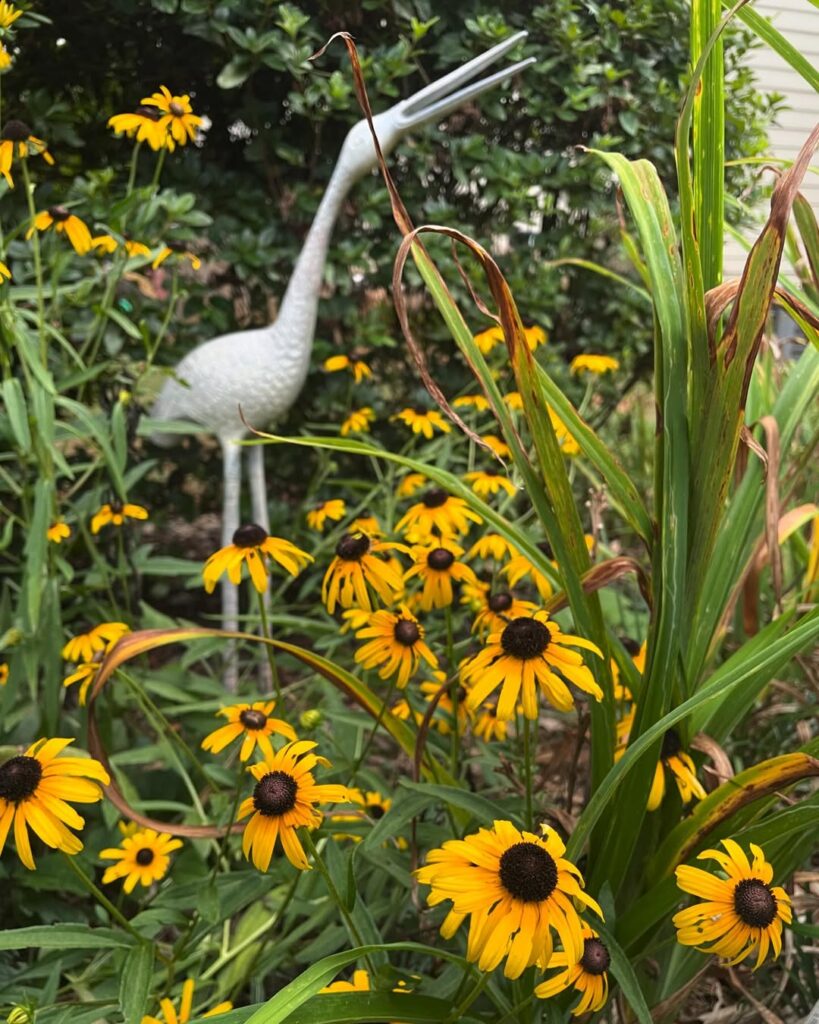
Black-Eyed Susan (Rudbeckia hirta) is a quintessential Iowa prairie wildflower that brings reliable summer color to native landscapes. Growing 1-3 feet tall, this adaptable plant produces cheerful daisy-like flowers with bright yellow petals surrounding dark centers from June through October. As a pioneer species, it quickly establishes in disturbed areas and thrives in prairie restorations.
This low-maintenance native serves multiple ecological functions, attracting diverse pollinators including bees, butterflies, and beetles while providing seeds for birds. Though typically behaving as a biennial with peak flowering in its second year, Black-Eyed Susan readily self-seeds to maintain populations. Its drought tolerance and ability to naturalize make it an excellent choice for wildflower meadows and prairie plantings.
For propagation, seeds can be sown in fall or spring, though spring-sown seed requires cold stratification to break dormancy and ensure successful germination.
- Hardiness: Annual, biennial, or short-lived perennial depending on conditions
- Light: Full sun
- Water: Low to moderate; drought-tolerant once established
- Soil: Well-drained, average to dry soils; adaptable to various soil types
- Fertilizer: None required; overly rich soils can reduce flowering
- Pest/Disease Resistance: Generally disease-resistant; occasionally affected by powdery mildew or leaf spot in poor conditions
- Growth Rate: Fast; blooms reliably in first year from seed
Wild Lupine (Lupinus Perennis)

Wild Lupine (Lupinus perennis) is a stunning native perennial featuring distinctive purple, pea-like flowers arranged in elongated spikes that bloom from April through July. This 1-2 foot tall member of the Fabaceae family displays attractive palmate leaves and serves as a vital host plant for the federally endangered Karner Blue Butterfly. As a nitrogen-fixing legume, Wild Lupine improves soil health while providing nectar for various pollinators including butterflies, bees, and other beneficial insects.
Native to Iowa’s prairies and open woodlands, Wild Lupine thrives in challenging conditions where other plants struggle. Its adaptability to dry, sandy soils and full sun exposure makes it an excellent choice for prairie restoration projects and naturalized landscapes. The plant’s low maintenance requirements and conservation value make it particularly valuable for butterfly gardens and pollinator habitats throughout the Midwest. Wild Lupine scores a coefficient of conservatism rating of 10 in Iowa, indicating its high fidelity to intact, high-quality ecosystems.
- Hardiness: Zones 3-8
- Light: Full sun to partial shade
- Water: Low to moderate; drought tolerant once established
- Soil: Dry, sandy, well-drained; acidic to circumneutral pH (6.8-7.2)
- Fertilizer: None needed; fixes its own nitrogen
- Pest/Disease Resistance: Good resistance when grown in proper conditions
- Growth Rate: Moderate
New England Aster (Symphyotrichum Novae-Angliae)
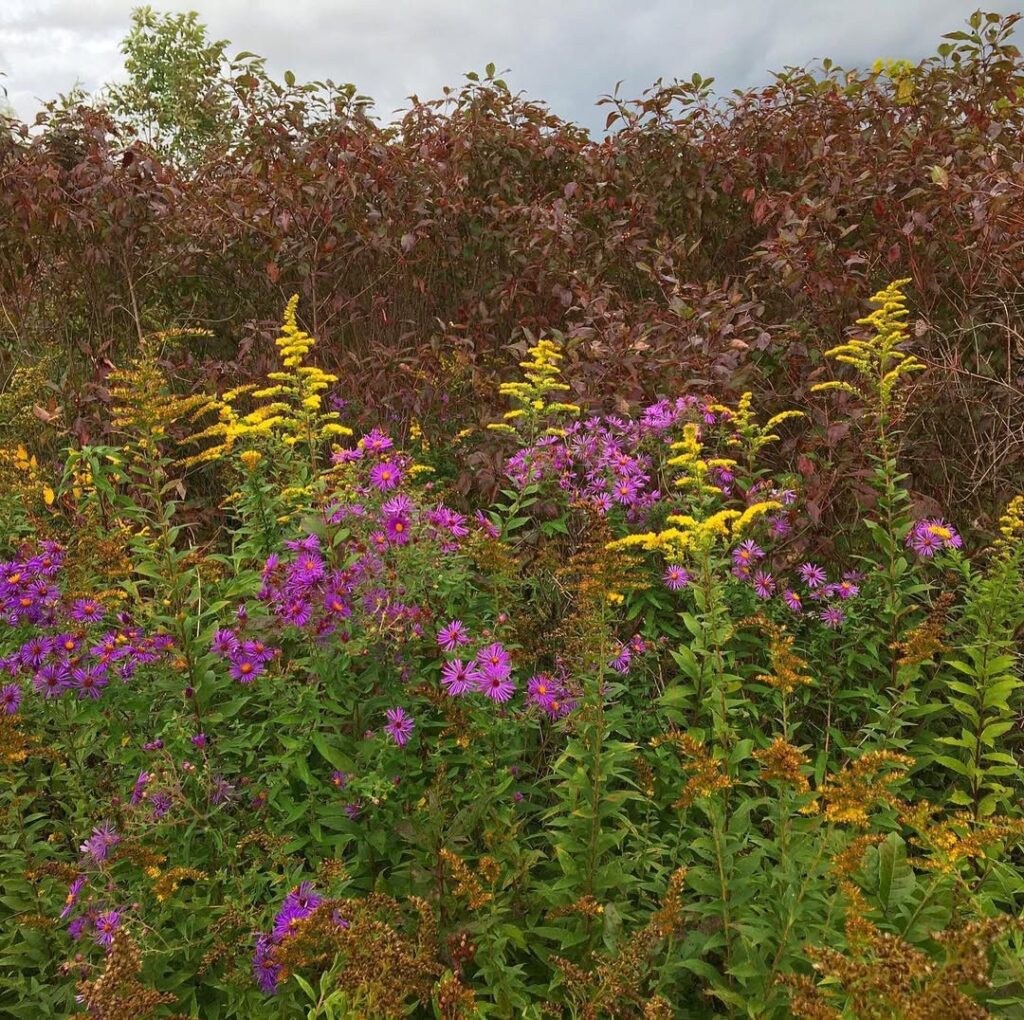
New England Aster is a stunning perennial wildflower native to Iowa’s prairies and moist meadows. Growing 3-6 feet tall in dense clusters, this late-blooming beauty produces showy purple to pinkish flowers with bright yellow centers from late summer through fall. It serves as an essential late-season nectar source for Monarch butterflies and other pollinators when few other resources remain available.
This robust native is ideal for prairie restoration, pollinator gardens, and conservation plantings. It integrates well with other late-blooming natives like goldenrods and prairie blazing star, making it perfect for establishing prairie strips in agricultural or urban environments. The plant also provides larval habitat for Pearl Crescent and checkerspot butterflies while offering excellent erosion control along roadsides and stormwater buffers. After establishment, this native provides no-mow beauty that adapts well to Iowa’s harsh winters and summer heat.
- Hardiness: Perennial, cold hardy in Iowa conditions
- Light: Full sun to part shade
- Water: Prefers moist conditions but drought tolerant once established
- Soil: Well-drained soils, adapts to variety of soil conditions
- Fertilizer: Minimal fertilizer needs, low maintenance
- Pest/Disease Resistance: Resistant to most insect pests and diseases
- Growth Rate: Moderate to fast, may be aggressive in moist fertile soils
Iowa Native Prairie Trees
Iowa’s native prairie trees, dominated by resilient oak species and hardy companions like American plum and hawthorn, provide essential wildlife habitat while thriving in challenging prairie conditions.
Bur Oak (Quercus Macrocarpa)

Bur Oak is Iowa’s most adaptable native oak, thriving across diverse habitats from moist floodplains to dry uplands. This massive deciduous tree reaches 50-80 feet with a broad, open crown that often exceeds its height. Known for producing the largest acorns among Iowa’s oaks, it serves as an essential wildlife food source while providing exceptional shade and visual interest through its deeply ridged bark and large, distinctively lobed leaves.
As a pioneer species in prairie landscapes, Bur Oak demonstrates remarkable resilience to harsh conditions including drought, compacted soils, and urban pollutants. Its slow but steady growth makes it an excellent long-term investment for landscapes seeking a durable, low-maintenance shade tree that supports local wildlife. The species begins producing acorns at approximately 35 years, establishing sustainable food sources for generations of wildlife.
- Hardiness: USDA Zones 3-9
- Light: Full sun
- Water: Drought tolerant once established; adaptable to both moist and dry conditions
- Soil: Highly adaptable; tolerates high pH, compacted, sandy, and limestone soils
- Fertilizer: Generally not required; thrives in poor soils
- Pest/Disease Resistance: Good resistance; susceptible to oak wilt if pruned during growing season
- Growth Rate: Slow, less than 12 inches per year
Eastern Cottonwood (Populus Deltoides)
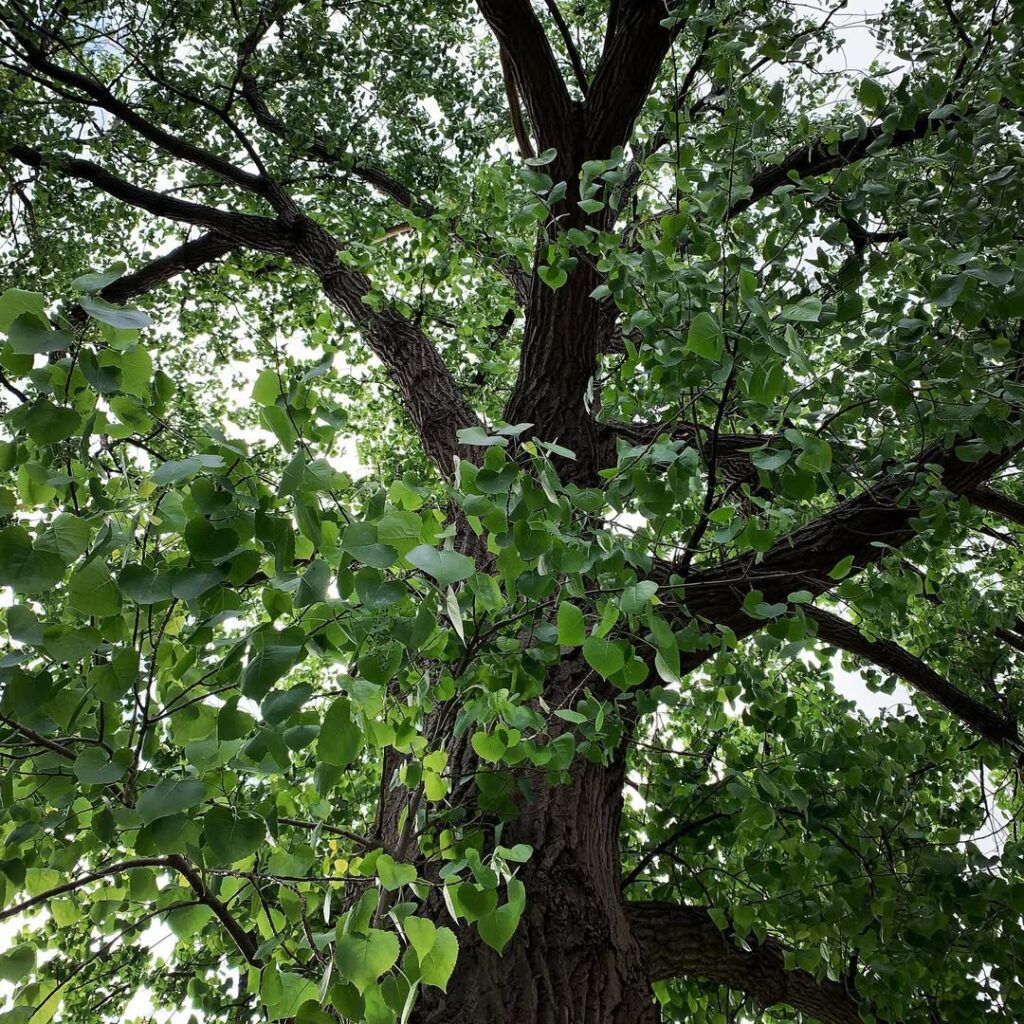
Eastern Cottonwood is a majestic native hardwood tree that can reach heights of 65-100 feet with a distinctive vase-shaped canopy. Its silvery-white bark darkens with age, and large triangular leaves with flat petioles create the characteristic rustling sound in wind. The tree produces cottony seeds in spring and offers excellent shade coverage.
As one of North America’s fastest-growing commercial forest species, Eastern Cottonwood can add 10-15 feet annually under ideal circumstances. While naturally found near water sources, it demonstrates surprising drought tolerance and air pollution resistance, making it valuable for large landscape applications despite its relatively short lifespan compared to other hardwoods. The wood is characterized as light and soft, making it suitable for manufacturing pallets, boxes, and crates rather than high-durability applications.
- Hardiness: USDA zones 3-9, native to Iowa
- Light: Full sun
- Water: Moderate to high; prefers consistent moisture but drought tolerant once established
- Soil: Adaptable to various soil types; prefers moist, well-drained soils near water sources
- Fertilizer: Low maintenance; rarely requires supplemental fertilization
- Pest/Disease Resistance: Good resistance to air pollution; susceptible to some canker diseases
- Growth Rate: Very fast; 5+ feet annually with potential for 10-15 feet in favorable conditions
American Elm (Ulmus Americana)

The American Elm is a majestic, vase-shaped deciduous tree native to Iowa that can reach heights of 60-80 feet. Once widely planted as a street and ornamental tree, it features distinctive dark-green leaves with toothed margins and produces winged seeds in spring. This hardy tree serves important ecological functions, hosting butterfly species and providing food and shelter for birds and small mammals.
Despite being severely impacted by Dutch elm disease, American Elm continues to persist in Iowa’s natural ecosystems. The tree is adaptable to various environmental conditions and was historically valued for its fast growth, excellent shade coverage, and attractive fall color. The species commonly grows in bottomland areas throughout Iowa’s natural landscapes.
- Hardiness: USDA zones 3-9, extremely cold hardy and adaptable to Iowa conditions
- Light: Full sun to light shade, performs best in full sun exposure
- Water: Medium moisture requirements, tolerant of both wet and dry conditions
- Soil: Adaptable to various soil types, prefers well-drained rich soil but tolerates diverse conditions
- Fertilizer: Low maintenance, typically does not require supplemental fertilization
- Pest/Disease Resistance: Susceptible to Dutch elm disease and bark beetles, ongoing research for resistant varieties
- Growth Rate: Fast growing, rapid establishment in suitable conditions
Eastern Red Cedar (Juniperus Virginiana)

Eastern Red Cedar is Iowa’s native evergreen tree, reaching 30-40 feet in height with aromatic, scale-like foliage that shifts from blue-green to bronze in winter. This hardy species thrives across diverse habitats from prairies to woodlands, offering year-round wildlife cover and food through its blue berries. The tree’s fibrous, reddish-brown bark and pyramidal crown make it an attractive landscape choice.
Valued for its exceptional durability and low-maintenance nature, Eastern Red Cedar serves multiple purposes from windbreaks to specimen plantings. Its rot-resistant wood has long been prized for outdoor construction, while the dense evergreen foliage provides excellent screening. Though aggressive in spreading, this resilient native adapts to poor soils and extreme weather conditions. This remarkable tree prefers circumneutral soil conditions with pH levels between 6.8 and 7.2.
- Hardiness: Zones 2-9, extremely tolerant of drought, heat, and cold extremes
- Light: Full sun preferred for best form and vigor
- Water: Drought tolerant once established, minimal water requirements
- Soil: Well-drained preferred, tolerates poor, rocky, or sandy soils
- Fertilizer: None required, thrives on neglect in most situations
- Pest/Disease Resistance: Generally resistant, cedar-apple rust concern near apple orchards
- Growth Rate: Moderate to fast growth rate
Hackberry (Celtis Occidentalis)
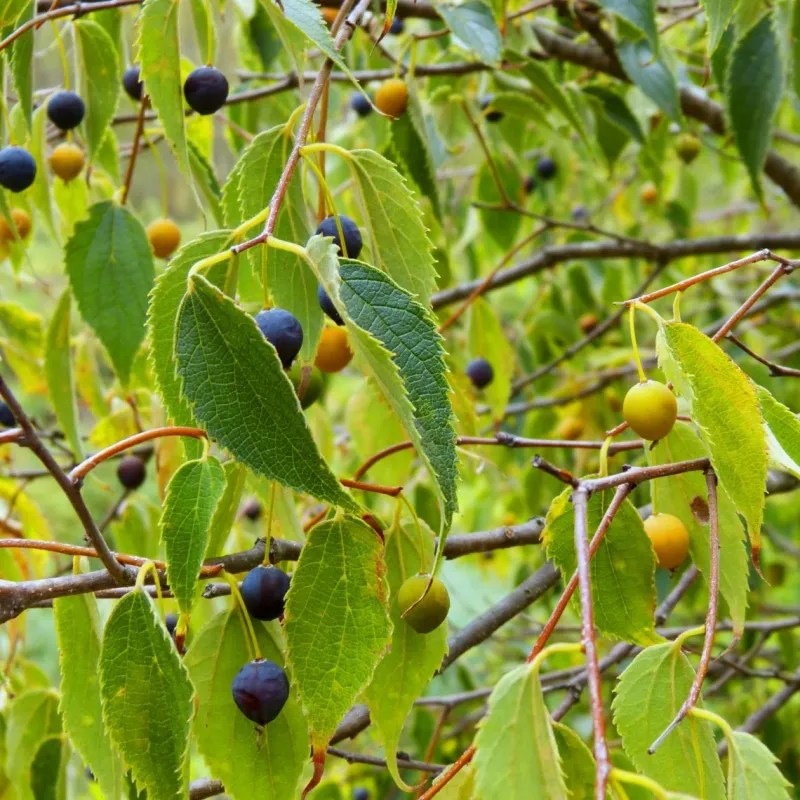
Hackberry is a fast-growing native Iowa tree that reaches 50-70 feet in height with an equally broad spread. This resilient species is prized for its distinctive light brown to silvery-gray bark with irregular ridges and scales, creating year-round visual interest. Its moderate lifespan of up to 200 years makes it an excellent long-term landscape investment.
Exceptionally adaptable to various growing conditions, hackberry thrives across Iowa’s diverse landscapes from valley floors to upland slopes. The tree provides significant ecological value as a host plant for several butterfly species and offers food and shelter for numerous birds and mammals. The dark purple fruits often persist through winter, providing an important food source for wildlife during harsh weather months. Its tolerance to urban stresses and rapid growth rate make it an increasingly popular replacement for ash trees affected by emerald ash borer.
- Hardiness: USDA zones 3-9, native to Iowa and Midwest
- Light: Full sun preferred
- Water: Wet to well-drained; drought tolerant once established
- Soil: Alkaline preferred, tolerates wide variety of soil types, pH 6.0-8.0
- Fertilizer: Generally not needed; adapts to various soil fertility levels
- Pest/Disease Resistance: Excellent resistance to drought, heat, wind, salt, and pollution
- Growth Rate: Fast, typically 24+ inches per year
Iowa Native Prairie Shrubs
Iowa’s native prairie shrubs provide essential wildlife habitat, soil stability, and drought resistance while offering low-maintenance landscaping solutions with diverse species, growth patterns, and significant conservation benefits. These woody plants typically remain under 8 meters in height and feature multiple stems that distinguish them from single-trunked trees.
Gray Dogwood (Cornus Racemosa)

Gray Dogwood is a versatile native deciduous shrub that forms attractive colonies through its rhizomatous growth habit. Reaching 10-15 feet in both height and spread, this member of the dogwood family offers year-round interest with cream-colored spring flowers, distinctive white berries on red stems in summer, and burgundy to yellow fall foliage.
This hardy shrub excels in challenging landscape conditions while providing exceptional ecological value. Its ability to form thickets makes it ideal for erosion control, windbreaks, and wildlife habitat. The berries feed numerous bird species, while the plant serves as a host for Azure butterflies and provides cover for small animals and migrant songbirds. The reddish-colored stems provide additional winter interest when leaves have fallen.
- Hardiness: USDA zones 3-8
- Light: Full sun to partial shade
- Water: Moist to well-drained soil; adapts to dry conditions
- Soil: Adaptable to poor fertility and compacted sites; pH 4.8-7.4
- Fertilizer: Low maintenance; adapted to poor fertility sites
- Pest/Disease Resistance: Generally resistant with few serious issues
- Growth Rate: Fast; 24+ inches per year
American Hazelnut (Corylus Americana)
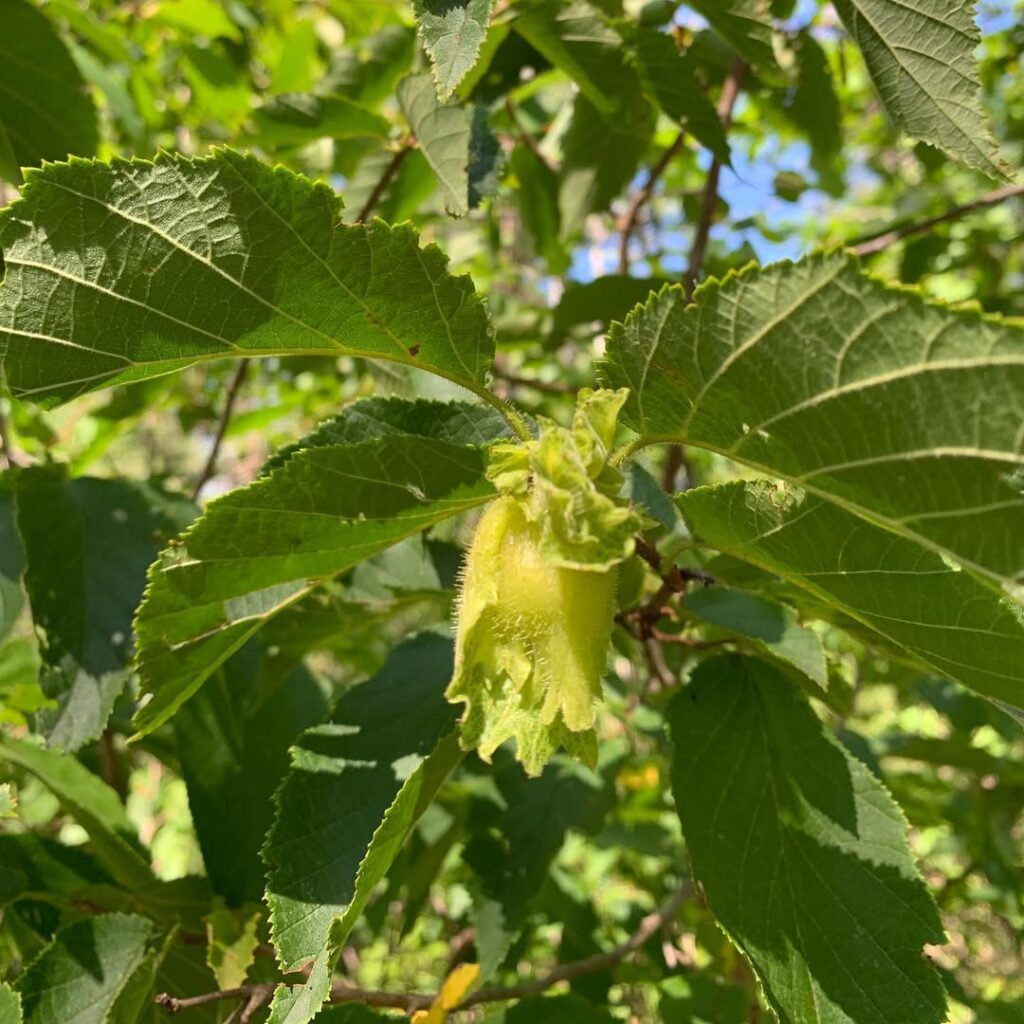
American Hazelnut is a versatile native shrub that brings multi-season interest to Iowa landscapes. This deciduous plant grows 6-15 feet tall, forming dense thickets through rhizome spread. It produces showy yellowish-brown catkins in late winter, followed by edible nuts in late summer and striking copper-yellow fall foliage.
Beyond its ornamental value, American Hazelnut serves as an ecological powerhouse, providing food and shelter for diverse wildlife including squirrels, birds, deer, and even bears. The sweet nuts were historically important to Native Americans and early settlers, making this shrub perfect for edible landscaping while supporting local ecosystems. The nuts develop within a distinctive ragged papery husk that splits open when mature.
- Hardiness: USDA Zones 4-9
- Light: Full sun to partial shade (best nut production in more sunlight)
- Water: Tolerates dry to moist conditions; prefers medium to moist, well-drained soil
- Soil: Adaptable to clay, loam, and sand
- Fertilizer: Low maintenance, no special fertilizer requirements
- Pest/Disease Resistance: Generally resistant with few issues
- Growth Rate: Moderate, spreads by rhizomes to form colonies
Elderberry (Sambucus Canadensis)
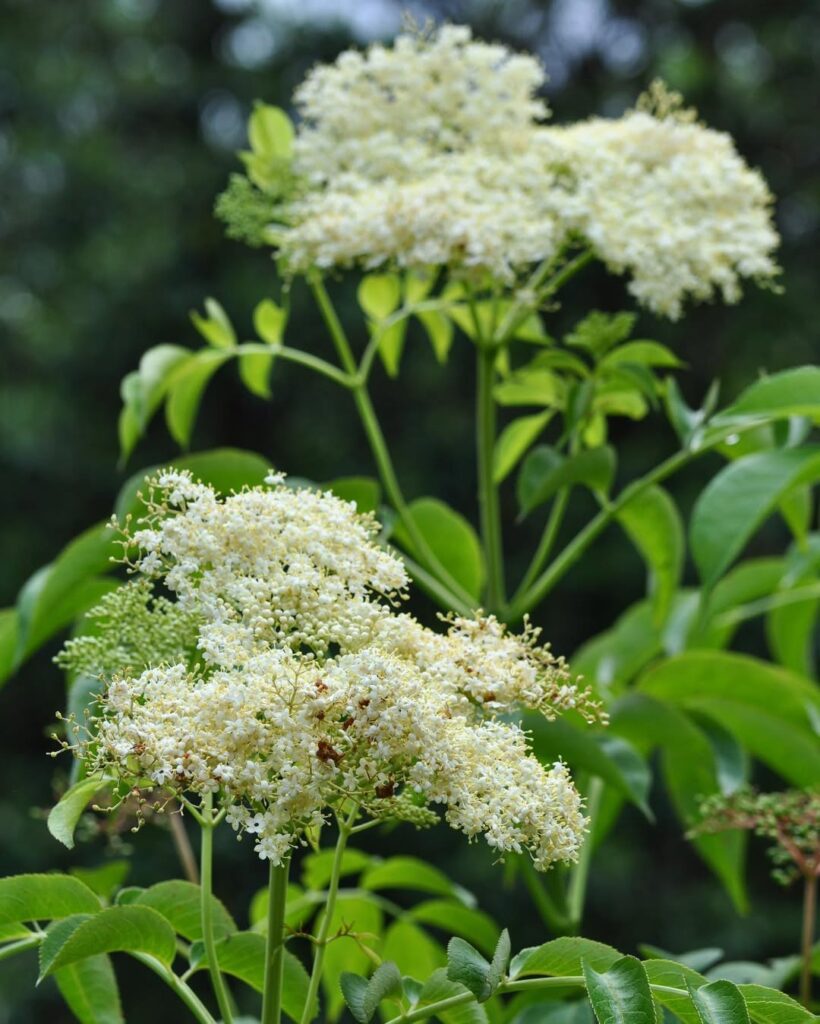
American black elderberry (Sambucus canadensis) is a versatile native shrub that reaches 5-12 feet tall with an attractive, spreading habit. This deciduous plant features pinnate leaves with serrated edges, flat-topped clusters of white flowers from late June through August, and dark purple-black berries that follow. As a tough, adaptable species native to all Iowa regions, elderberry serves as an excellent choice for naturalized landscapes and prairie restoration projects, providing both ornamental value and important wildlife habitat.
The multi-stemmed shrub displays light grayish-brown bark with distinctive lenticels and produces arching branches that create an open, rounded form. Its medium growth rate and low maintenance requirements make it ideal for establishing quickly in new plantings while providing shelter for slower-growing woodland species. The ripe berries can be processed into traditional jams and jellies, though cooking and straining is recommended to remove seeds and reduce compounds found in unprocessed parts of the plant.
- Hardiness: USDA zones 4a-8b
- Light: Full sun to partial shade (2-6 hours direct sunlight)
- Water: Moist to occasionally wet conditions; drought tolerant once established
- Soil: Adaptable to clay, loam, sand, and high organic matter; acidic to neutral pH (6.0-8.0)
- Fertilizer: Low requirements; benefits from organic matter
- Pest/Disease Resistance: Very tough and resistant
- Growth Rate: Medium to fast growth rate
Wild Plum (Prunus Americana)
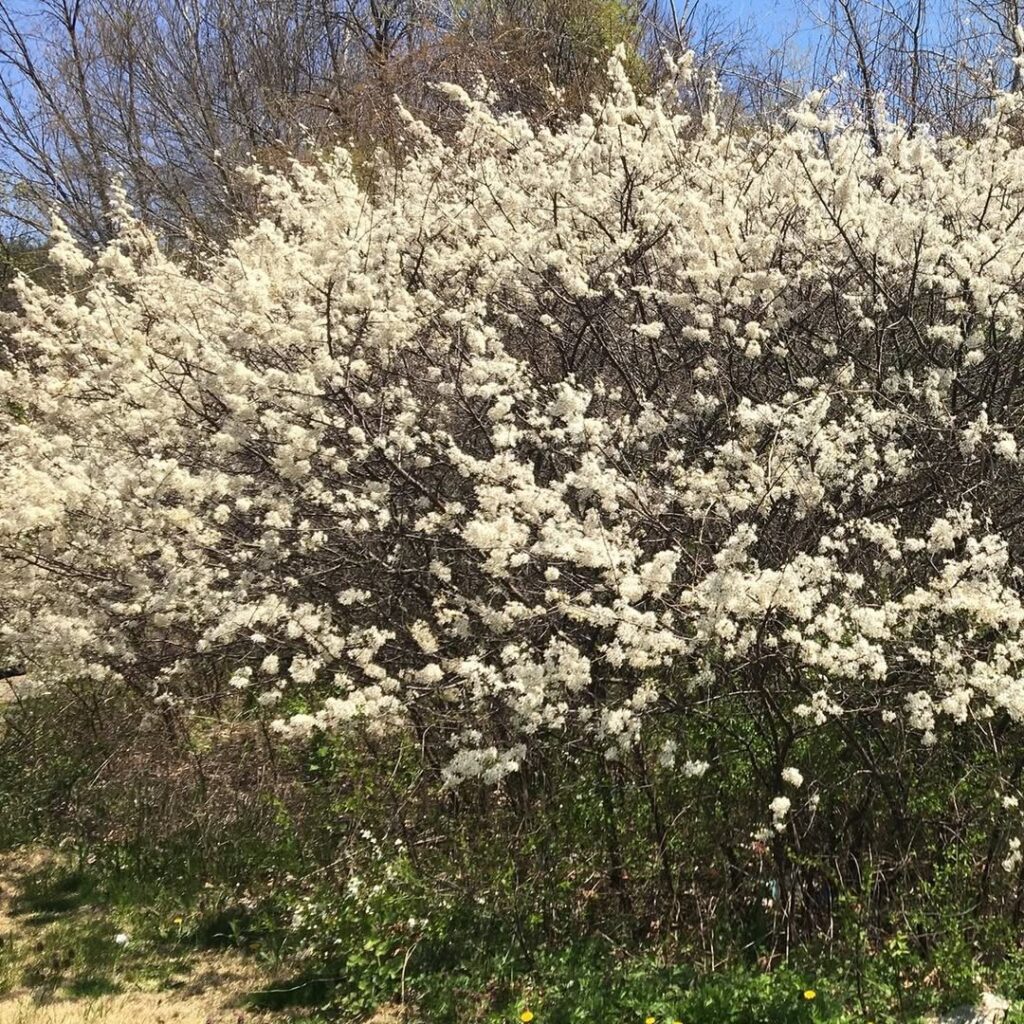
Wild plum is a versatile Iowa native that forms dense thickets through root suckers, making it excellent for natural hedges and erosion control. This low-branched shrub or small tree reaches 10-25 feet tall with a spreading crown, producing fragrant white flower clusters before leaves emerge in early spring.
The bright red to purple fruits ripen in late summer and are prized by both wildlife and humans for jellies and preserves. Its exceptional wildlife value includes providing nesting habitat for songbirds and early-season nectar for pollinators, while the attractive fall foliage adds seasonal interest to prairie landscapes. The wrinkled appearance leaves are alternate and simple with single teeth, measuring 3 to 4 inches long with distinctively long pointed tips.
- Hardiness: USDA zones 3-8, tolerates temperatures to -40°F
- Light: Full sun to partial shade; best flowering and fruiting in full sun
- Water: Moist to well-drained; tolerates occasional drought but not prolonged dry periods
- Soil: Adaptable to various textures including clay; pH 5.0-7.0; not salt tolerant
- Fertilizer: Low maintenance; typically requires no supplemental fertilization
- Pest/Disease Resistance: Generally resistant; tolerates walnut toxicity
- Growth Rate: Fast-growing, up to 24+ inches per year under favorable conditions
Smooth Sumac (Rhus Glabra)
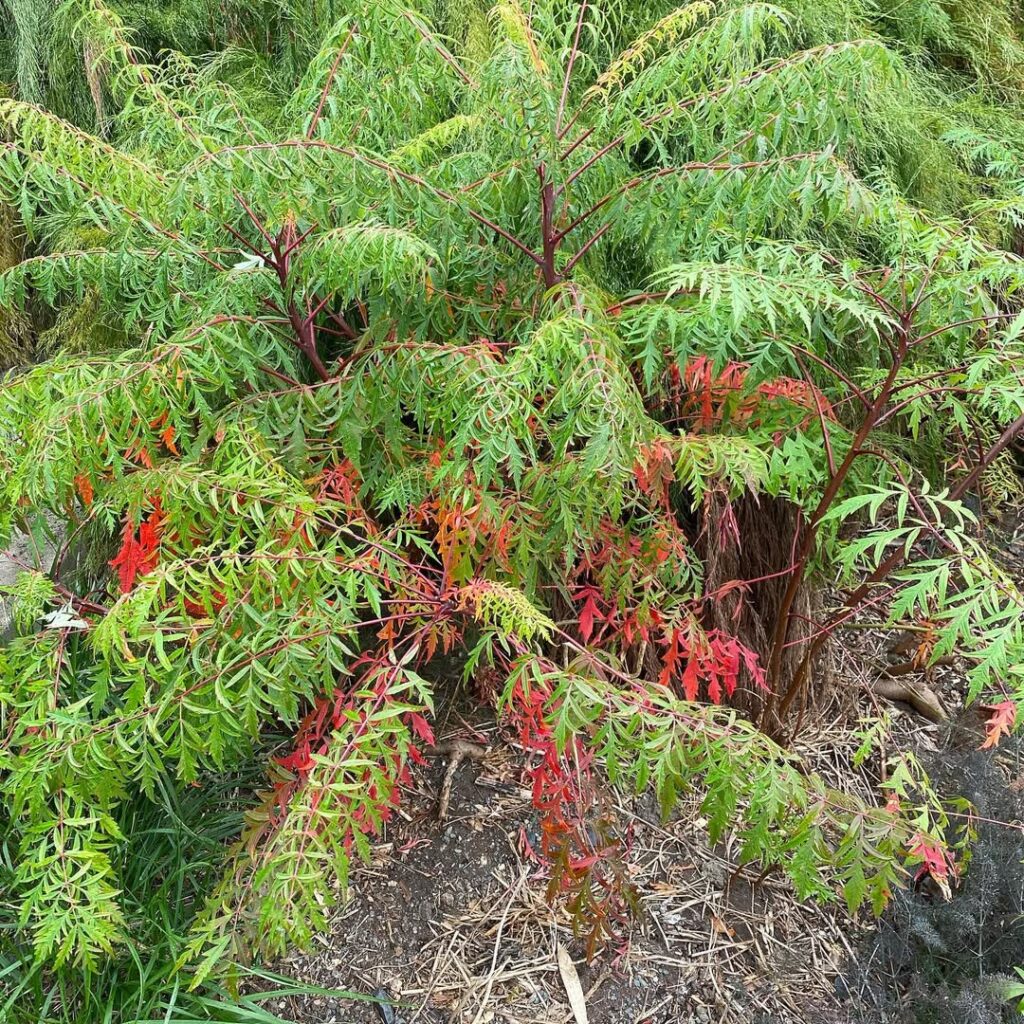
Smooth sumac is a versatile native shrub that thrives throughout Iowa’s diverse landscapes. Growing 10-20 feet tall, this deciduous plant features distinctive compound leaves with serrated leaflets that transform into brilliant red autumn displays. The shrub produces clusters of yellow-green to white flowers followed by bright red berry clusters on female plants that persist through winter, providing essential food for wildlife.
This hardy prairie native excels in naturalizing large areas and erosion control due to its colonizing growth habit. Dense thickets offer valuable habitat for birds and small mammals while supporting pollinators during the flowering season. Remarkably, smooth sumac holds the distinction of being the only shrub native to all 48 contiguous states, making it an exceptionally well-adapted species for diverse American landscapes. With minimal maintenance requirements and exceptional adaptability to challenging conditions, smooth sumac serves as an excellent choice for prairie restorations, naturalistic landscapes, and areas requiring low-maintenance yet attractive plantings.
- Hardiness: Zones 2-9
- Light: Full sun to partial shade
- Water: Drought tolerant once established; minimal watering needed
- Soil: Adaptable to poor, rocky, alkaline, or slightly acidic soils
- Fertilizer: None required; thrives in nutrient-poor conditions
- Pest/Disease Resistance: Excellent resistance to most pests and diseases
- Growth Rate: Fast-growing with colonizing habit
Selecting the Right Native Plants for Your Garden
Since Iowa’s prairie ecosystem contains hundreds of native species, you’ll need a focused approach to choose the right plants for your specific garden conditions. Start by matching moisture requirements to your site—drought-tolerant Side-oats Grama for dry areas, Blue Flag Iris for wet spots. Plan bloom succession from early Echinacea through late-season Joe Pye Weed for continuous color. Consider plant maintenance needs; native grasses require minimal care once established. Your garden design benefits from mixing heights—towering Big Bluestem with ground-level Wild Geranium. Choose Iowa-specific natives over general varieties for better adaptation and reduced maintenance headaches. The rich soil and adequate rainfall throughout Iowa provide ideal growing conditions that support the natural establishment of these diverse prairie species.
Frequently Asked Questions
How Long Does It Take for Prairie Native Plants to Establish?
Like watching children grow into adults, your prairie establishment timeline spans 3-5 years before reaching maturity. Growth factors including soil conditions, seeding timing, and maintenance practices determine how quickly you’ll see results.
Can Prairie Plants Survive Iowa’s Harsh Winter Conditions Without Protection?
You’ll find prairie plants demonstrate exceptional winter resilience through their extensive root systems and natural plant hardiness. They’re specifically adapted to Iowa’s harsh conditions, surviving extreme cold, wind, and temperature fluctuations without requiring additional protection.
Where Can I Purchase Native Prairie Seeds and Plants in Iowa?
You’ll find seed suppliers like Blooming Prairie Nursery and The Prairie Flower offer native plants throughout Iowa. Simply Native Nursery also provides locally-sourced options, while Iowa State Extension maintains updated directories of regional suppliers.
Do Prairie Plants Require Special Soil Preparation Before Planting?
You’ll need to prepare soil composition by removing weeds and creating a firm, fine seedbed. Proper planting techniques include light tilling without excessive disturbance, ensuring good seed-to-soil contact for successful establishment.
How Much Maintenance Do Established Prairie Gardens Need Annually?
You’ll need minimal garden upkeep once your prairie’s established. Annual evaluation determines maintenance frequency – spot-treat weeds as needed, mow or hay between July 15-August 31, and conduct prescribed burns every 3-5 years.
